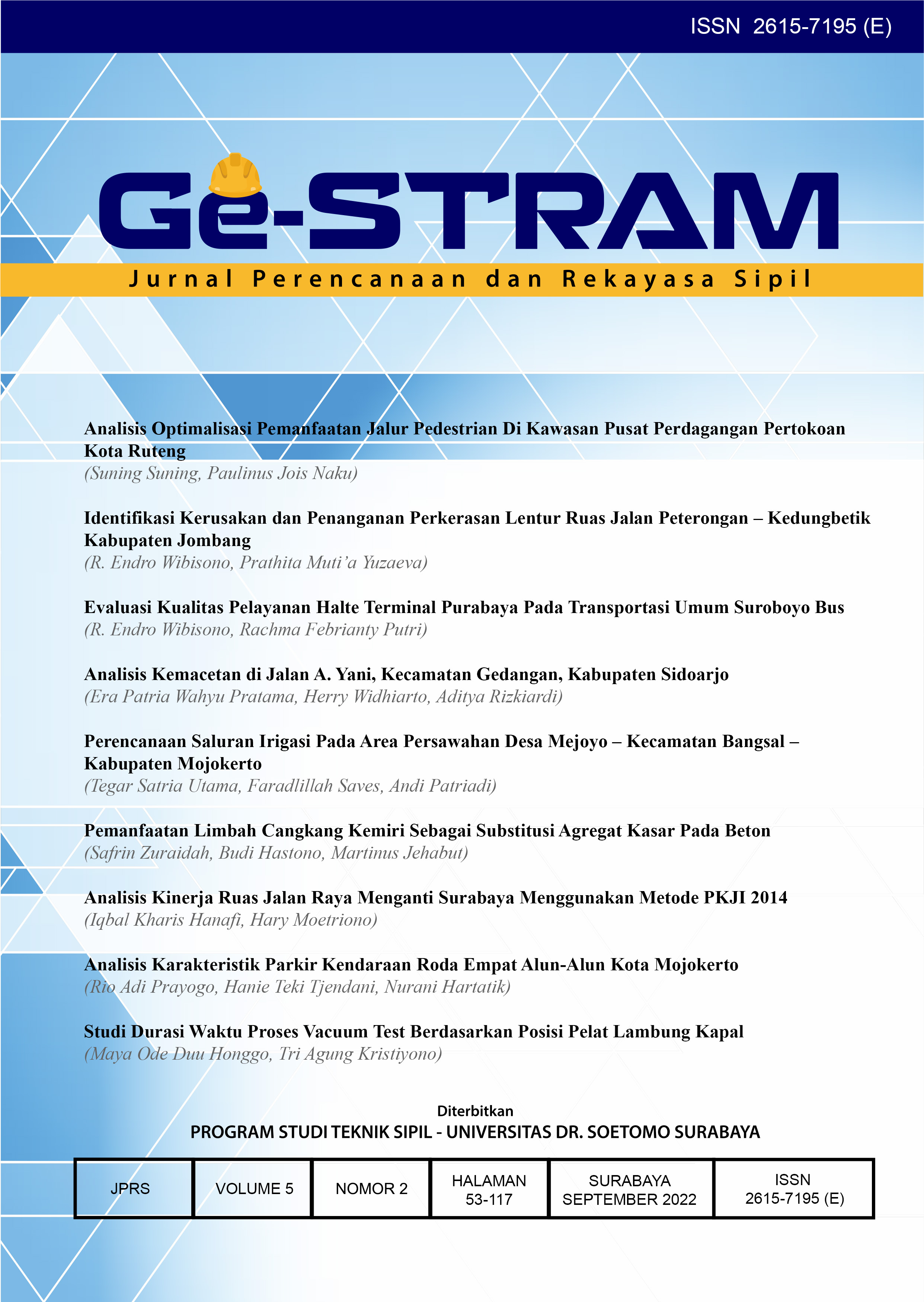Identifikasi Kerusakan dan Penanganan Perkerasan Lentur Ruas Jalan Peterongan – Kedungbetik Kabupaten Jombang
 Abstract views: 471
,
Abstract views: 471
,
 PDF downloads: 1333
PDF downloads: 1333
Abstract
Peterongan - Kedungbetik Road section is one of the alternative routes from Mojokerto to Jombang. On the Peterongan - Kedungbetik Road Section, there are several types of damage. Road damage is a condition where the structural and functional on the road is no longer able to provide optimal service to traffic that crosses the road. As much as the need for appropriate action in dealing with damage that occurs to the Peterongan - Kedungbetik Road Section to be able to achieve the life of the road plan and comfort and safety for road users. The purpose of this observation is to identify the type of damage, to find out the extent of damage that occurs, to know the appropriate handling method in handling damage, and to find out the handling process carried out by the Jombang Regency Public Works and Spatial Planning Office. The method used in this observation is the method of direct observation in the field and and data collection through observation, literature and documentation so that it can analyze the damage data on the Peterongan - Kedungbetik Road Section. The results of this observation analysis are the type of damage that occurred, the calculation of the level of damage, how to handle the damage, the work instruments that can be carried out for handling damage, the process in the field when handling damage and an assessment of the process carried out in accordance with the provisions governing road maintenance. With the results of the analysis, it can be concluded that the types of damage that occur are longitudinal cracks, holes and grain release. So that a follow-up process is needed so that the damage does not get worse with proper handling so as to provide comfort and safety for road users
References
Ariyanto.,dkk. (2021). “Analisis Kerusakan Jalan Menggunakan Metode Bina Marga 1990â€.Jurnal DISPOTEK Vol.12 No. 1.
Binamarga.pu.go.id. (2018). “Pentingnya Drainase Cegah Kerusakan Jalanâ€. Diakses pada 17 Mei 2022, dari https://binamarga.pu.go.id/balai-jatim-bali/index.php?/berita/detail/pentingnya-drainase-cegah-kerusakan-jalan.
Direktorat Jenderal Bina Marga. (1997). “Manual Kapasitas Jalan Indonesia (MKJI)â€, Departemen Pekerjaan Umum, Jakarta.
Direktorat Jendral Bina Marga. (1990). Tata Cara Penyusunan Program Pemeliharaan Jalan Kota No. 018/T/BNKT/1990.
Direktorat Jendral Bina Marga. (2017). “Panduan Pemilihan Teknologi Pemeliharaan Preventif Perkerasan Jalan†No. 07/SE/Db/2017.
Kurrahman, Taufik. (2021). “Analisa Kerusakan Jalan Berdasarkan Metode Bina Margaâ€.Jurnal Ilmu Teknik. Vol. 17 No 1.
Peraturan Menteri Pekerjaan Umum. “Sistem Manajemen K3 Konstruksi Bidangâ€. Nomor: 09/PRT/M/2008.
Peraturan Menteri Pekerjaan Umum. “Tata Cara Pemeliharaan dan Penilikan Jalanâ€. Nomor :14/PRT/M/2011.
Pratiwi,Evitriana Dessy. (2021). “Penanganan Kerusakan Jalan Kabupaten Menggunakan Metode Bina Marga Pada Jalan Sepaku – Perigi Kabupaten Lamandauâ€. Jurnal Spektrum Sipil Vol. 8 , No.2:97
Setiawan,Dian.,dkk. (2021). “Penentuan Metode Pemeliharaan dan Penanganan Lapis Permukaan Lentur Jalan Menggunakan Metode Pavement Condition Index (PCI)â€. Jurnal Ilmiah Indonesia. Vol.6, No.1.
Widayanti, A., Wibisono, R.E. and Sari, C.K., (2020). “Tipe Kerusakan Jalan Provinsi dan Penentuan Skala Prioritas Penanganan di Kabupaten Lamonganâ€. Publikasi Riset Orientasi Teknik Sipil (Proteksi), 2(2), pp.73-83.
Copyright (c) 2022 R Endro Wibisono, Prathita Muti’a Yuzaeva

This work is licensed under a Creative Commons Attribution-ShareAlike 4.0 International License.
Authors who publish with this journal agree to the following terms:
- Authors retain copyright and grant the journal right of first publication with the work simultaneously licensed under a Creative Commons Attribution-ShareAlike 4.0 International License that allows others to share the work with an acknowledgement of the work's authorship and initial publication in this journal.
- Authors are able to enter into separate, additional contractual arrangements for the non-exclusive distribution of the journal's published version of the work (e.g., post it to an institutional repository or publish it in a book), with an acknowledgement of its initial publication in this journal.
- Authors are permitted and encouraged to post their work online (e.g., in institutional repositories or on their website) prior to and during the submission process, as it can lead to productive exchanges, as well as earlier and greater citation of published work (See The Effect of Open Access).

This work is licensed under a Creative Commons Attribution-ShareAlike 4.0 International License.















